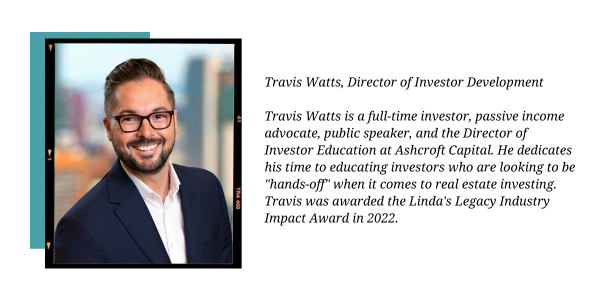December 29, 2022
In the fourth episode of Multifamily Market Report I cover inflation, the impact of inflation on the real estate market, what we saw last year and this year, and what we might expect in 2023.
Multifamily apartments are a resilient asset class, and we can see this by looking at past recessions, such as the dot-com crash, the Great Recession, and the Pandemic Recession. In general, multifamily performs well in up-trending markets, flat markets, and even in declining markets. Let’s uncover why that is.
According to research by Coldwell Banker Richard Ellis (“CBRE”), if we look at the national stats, in preexisting class B apartments during the Great Recession (2008–2010) rents fell by only $125 per month. The recovery was quick as Americans needed affordable housing during the recession, and many lost their homes. Once rents bottomed out, the rent decline was short lived. It took less than two years to get back to prerecession rent pricing levels.
So what’s happening right now? Looking at the government’s consumer price index (CPI) reading (you can learn more at www.bls.gov ) reveals that we’ve been running at 40-year high inflation. The CPI measures the increase in the cost of goods, services, housing, and so on. All items are indexed into a “basket of goods” that allows the government to measure the inflation rate. The government runs the numbers every month, and that’s how it comes up with the annualized inflation rate. We have been running hot on inflation (7%–9% annualized) for the majority of 2022.
While inflation is not necessarily good news for consumers with the cost of groceries, gas, and everyday essentials increasing, there is a silver lining for multifamily apartments.
You may have seen headlines over the past two years stating that home building costs have risen at unprecedented rates. In fact, the cost of materials required to build an average-sized, single-family home increased 42 percent from 2018 to 2021, adding material costs of roughly $35,000 to the total cost of building. With inflation pushing up the price of materials, preexisting, multifamily housing tends to follow the inflationary trend as the cost of and demand for affordable housing increases as well. As single-family homes become more expensive, more people are priced out of the market, resulting in a higher demand for apartments. As a result, there is a severe nationwide shortage of affordable, safe, workforce housing.
Source: https://www.npr.org/2022/07/14/1109345201/theres-a-massive-housing-shortage-across-the-u-s-heres-how-bad-it-is-where-you-l
You can think of it like this: Let’s say a real estate investor bought a single-family home in 2020 and rented it out. If the investor paid all cash and charged $2,500 per month in rent and the expenses for owning that property were $500 per month, the investor would net $2,000 per month. If we multiply that by 12 months, we get $24,000 per year in cash flow. Last, if we take that $24,000 and divide by the purchase price of the home (we’ll call it $300,000), that results in an 8 percent annualized return.
Because the housing market went up between 2020 and 2021, the investor decided to sell that property for $400,000. As a result, the next buyer must figure out how to make a profit based on the higher purchase price. If the next investor decided to buy the property at $400,000 and did not increase the rent, the new owner would be looking at a 6 percent annualized return instead of the previous 8 percent. So in order to generate an 8 percent return (assuming that is the goal), the new buyer would need to raise the rent to $3,150 a month. The following is the breakdown of how the 8 percent annualized returns would be generated:
– Monthly holding cost is $500
– Net profit is $2,650 per month
– Multiplied by 12 months equals $31,800 annually
– Divide by the purchase price of the home ($400,000)
– The result is an 8 percent annualized return
The simple takeaway is that with high inflation, rents tend to increase. What we have not addressed yet is a value-add business plan. Value-add refers to adding value to both the residents and property through renovations and upgrades. Some examples of value-add would include the following:
– Renovating apartment units and the clubhouse
– Improving the landscaping
– Renovating or adding amenities (e.g., pools, gyms, dog parks, and barbecue areas)
– Adding resident features (e.g., covered car parking, fencing for ground-level yards, package locker systems, in-house security systems, USB charger outlets, smart thermostats)
A value-add business plan can create an updated look and feel and provide a safer and nicer place to live. Because the residents have a higher quality of life, there can be justification for raising the rents. That is another way investors can benefit despite the general market trend.
Of course, it’s not all good news. Inflation’s running at 40-year highs, and the Fed Funds Rate today has not increased to where it was in the early 2000s (around 6.5%) and is not even close to the all-time highs of the 1980s. To help tackle inflation, the Federal Reserve has been raising rates all year, and it has suggested there are more rate hikes on the horizon. And with the higher interest rates, more borrowing costs are passed on to the next buyer.
When mortgage rates increase from 3 percent to 6 percent, as we have seen over the past year, it makes buying real estate more expensive. If we consider a 30-year fixed rate mortgage at 3 percent interest and a loan balance of $300,000, the payment falls somewhere around $1,265 per month. But if we raise the interest rate to 6 percent, the payment is closer to $1,799 per month.
This is what we’re experiencing this year, and it leaves investors with two options. You could try to negotiate a discount and ask the seller to reduce the price of the property to help offset the higher borrowing costs, or you could buy the property anyway and look for ways to raise the rent.
The first option has a negative impact on real estate pricing. If price cuts start happening on a large scale, this brings comparable sales down, which drags the price of real estate down. But the second option—raising rents—is an opportunity for investors. Rents rising with inflation, combined with a value-add business plan and discounted properties due to interest rates, may be the opportunity of 2023.
A few things to consider in 2023 if you’re going to be investing:
#1: Understand that real estate is local. For example, according to Yardi Matrix, San Francisco multifamily properties experienced only a 4 percent annual rent growth in 2021 whereas Tampa experienced more than 20 percent growth.
#2: The type of business plan you consider is important. For example, with an existing multifamily that already has renters in place, you have the ability to raise rents whereas a new developer does not have renters yet and may have higher interest rates to consider on construction loans. The developer also has higher labor costs to consider, nationwide worker shortages, and worldwide supply chain issues. In addition, if interest rates continue to rise, the property’s potential selling price may be lower once it’s completed.
#3: The type of real estate you choose matters. Multi-family, single-family, self-storage, hotels, retail, medical offices, industrial, and mobile home parks all fall under the category of real estate, but each is unique. For example, office rents were up 1.2% year-over-year as of August 2021-2022. At the same time, multi-family rents were up over 10% nationally according to Yardi Matrix.
Final Thoughts:
Inflation can be positive or negative depending on your investment strategy. 2023 is a year to use caution, conduct proper due diligence, and invest wisely with experienced operators who are underwriting conservatively.
“Look at market fluctuations as your friend rather than your enemy; profit from folly rather than participate in it.” – Warren Buffett
Source: https://www.azquotes.com/quote/40665
To Your Success
Travis Watts
Watch Multifamily Market Report episode 4 below.
To watch more episodes of the Multifamily Market Report, please visit our YouTube channel at www.youtube.com/c/AshcroftCapital. As always, if you have any questions, you can reach me at Travis@ashcroftcapital.com.



